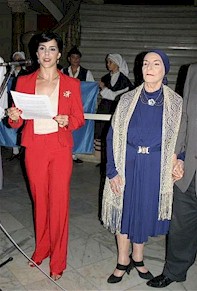MIREYA CASTAÑEDA / PHOTOS: NANCY REYES – The 24th Huella de España (Imprint of Spain) Festival confirmed, with a “cascade of functions with the presence of Cuban artists,” the profound roots of Iberian culture in Cuba, particularly that of Andalusia, the region to which this festival is dedicated.

The quote comes from the diva Alicia Alonso, honorary president of the Festival and general director of the National Ballet of Cuba. She was speaking at a press conference in Havana’s Andalusian Center, right on Paseo de Prado Boulevard.
For the prima ballerina assoluta, the many Cuban artistic groups based on flamenco song and dance “are the product of this imprint.” She emphasized the strength of the Hispanic heritage, given that “one’s blood is never forgotten.”
From words to gestures and work, including a valuable photographic exhibition (in the lobby of the Lorca Theater), titled Lo hispánico en el arte de Alicia Alonso, in which this Hispanic heritage can be appreciated, as the poet Antonio Machado would say, whether as a dancer or a choreographer.
The 2012 Festival (May 27 through June 3) was directed this year by the ballerina Irene Rodríguez (who founded her own Spanish dance company this year). In organizing it, she followed a 23-year tradition, trying to infuse modern touches and some innovations, like a flamenco club every night in the Andalusian Center, for the companies Eco, A mi aire, Toques del Río and A compás flamenco.
Although the inauguration of the Festival followed tradition by opening with the 9:00pm cannon firing session and Luis Carbonell, “the watercolorist of Antilles poetry,” declaiming Nicolás Guillén’s “Balada de los dos abuelos,” it was in a different setting: not the Castillo de la Real Fuerza explanade, but the Gran Teatro de La Habana’s García Lorca hall.
The strength of the Andalusian heritage in Cuba made itself felt from the first Gala performance: Ernesto Lecuona’s Andalucía; the young group Toques del Río from Pinar del Río province; the Spanish Ballet of Cuba and La boda de Luis Alonso; Suite Lecuona from the Lizt Alfonso Ballet; and singer Ivette Cepeda and two very successful pieces, Joaquín Sabina’s “Contigo,” and “Tu nombre me sabe a hierba,” by Joan Manuel Serrat.
The Gala closed with Sevilla, performed by pupils at the Andalusian Center School and a procession led by the Cuban Federation of Spanish Societies, carrying flags from Spain’s different communities.
Moving from stages to the academic sphere, there were eloquent lectures on “The presence in Cuba of Juan Ramón Jiménez”; “Federico García Lorca and Rafael Alberti, poets and friends,” given by Aitana Alberti; and “Lorca’s presence in Cuba” (these three in the Museum of Fine Arts’ Universal Art Building); and “Hispanic elements in the art of Alicia Alonso,” in the Museum of Dance.
The Garcia Lorca Theater had a marked presence as, in addition to the lecture, the National Ballet performed Preciosa y el aire, and in El Sótano Hall, the Teatro de la Villa de Guanabacoa offered their version of La zapatera prodigiosa.
The final touch to the imprint of García Lorca and of the Festival was the world premiere of El crimen fue en Granada, a piece inspired by the poem of the same name by Antonio Machado, written 75 years ago, choreographed by Irene Rodríguez and interpreted by her youthful company.
Outstanding performances were given by the soprano Johanna Simón in the Museum of Fine Arts Theater; the Sine Nomine vocal ensemble in the recently inaugurated Concert Hall in Havana’s former Casino Español on Paseo de Prado; and the Ars Longa Ancient Music Ensemble in the San Francisco de Paula Church.
Spanish cinema was also represented, with films from the Seville director Benito Zambrano, a graduate of the San Antonio de los Baños International Film School (Solas, Habana Blues, La voz dormida) and the presence of Maria Juncal, National Dance Prize winner in Spain who, for three years now, has been acting as advisor to a cultural program in Havana’s Los Sitios neighborhood, sponsored by the Antonio Gades Foundation.
Alicia Alonso, an eminent figure of universal dance, has been highly honored by Spain: an Honorary Degree from the University of Valencia, the Isabel la Católica Order (given by the King of Spain) and the Gold Medal for Merit in the Fine Arts (from the Spanish government).
The prima ballerina assoluta wrote in the catalogue of his 24th edition, “The Huella de España is a celebration of tradition and a tribute to our roots. Peoples have the right to receive the most valuable of their historical and cultural heritage and, on this foundation, to develop in new ways. Music, dance, literature and the visual arts will reach spectators in this celebration, translated into a message of love and peace… We shall once again find each other in the fascinating world of imagination and creativity.”
Source: http://www.granma.cu/ingles/culture-i/7jun-Huella.html
